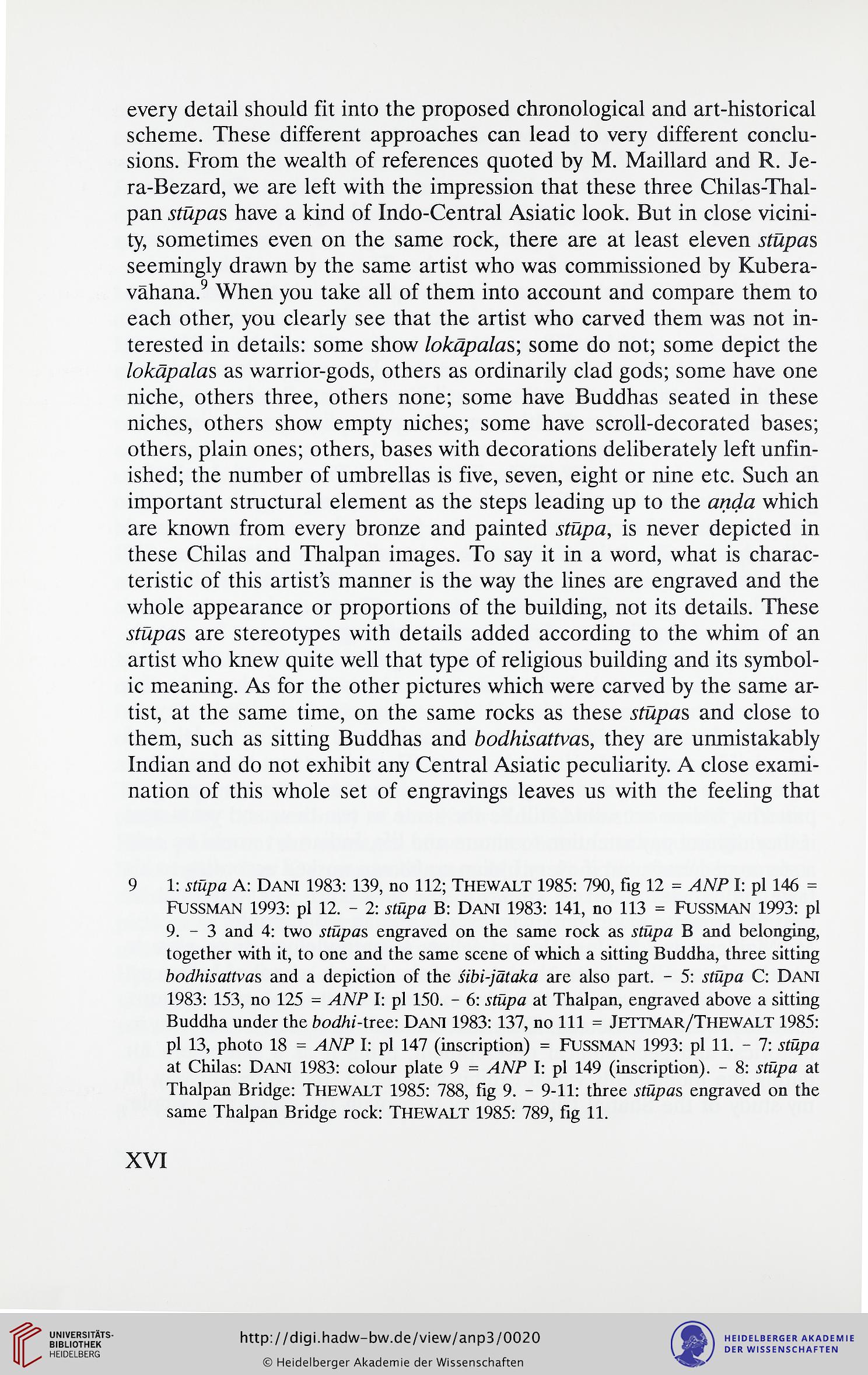every detail should fit into the proposed chronological and art-historical
scheme. These different approaches can lead to very different conclu-
sions. From the wealth of references quoted by M. Maillard and R. Je-
ra-Bezard, we are left with the impression that these three Chilas-Thal-
pan stupas have a kind of Indo-Central Asiatic look. But in close vicini-
ty, sometimes even on the same rock, there are at least eleven jfMpas
seemingly drawn by the same artist who was commissioned by Kubera-
vahana.^ When you take all of them into account and compare them to
each other, you clearly see that the artist who carved them was not in-
terested in details: some show /okapa/as; some do not; some depict the
/ckapa/as as warrior-gods, others as ordinarily clad gods; some have one
niche, others three, others none; some have Buddhas seated in these
niches, others show empty niches; some have scroll-decorated bases;
others, plain ones; others, bases with decorations deliberately left unfin-
ished; the number of umbrellas is five, seven, eight or nine etc. Such an
important structural element as the steps leading up to the aaJa which
are known from every bronze and painted jfapa, is never depicted in
these Chilas and Thalpan images. To say it in a word, what is charac-
teristic of this artist's manner is the way the lines are engraved and the
whole appearance or proportions of the building, not its details. These
.sfnpas are stereotypes with details added according to the whim of an
artist who knew quite well that type of religious building and its symbol-
ic meaning. As for the other pictures which were carved by the same ar-
tist, at the same time, on the same rocks as these stupas and close to
them, such as sitting Buddhas and &o^/iMaPvas, they are unmistakably
Indian and do not exhibit any Central Asiatic peculiarity. A close exami-
nation of this whole set of engravings leaves us with the feeling that
9 1: Jtapa A: DANI 1983: 139, no 112; THEWALT 1985: 790, fig 12 - ANP 1: pi 146 -
FussMAN 1993: pi 12. - 2: ^tapa B: DANI 1983: 141, no 113 = FussMAN 1993: pi
9.-3 and 4: two .slapas engraved on the same rock as itapa B and belonging,
together with it, to one and the same scene of which a sitting Buddha, three sitting
hoJ/a^attvas and a depiction of the .H&i'-jata/ca are also part. - 5: ytapa C: DANI
1983: 153, no 125 = ANP F pi 150. - 6: ^tapa at Thalpan, engraved above a sitting
Buddha under the hc<Pa-tree: DANI 1983: 137, no 111 = JETTMAR/THEWALT 1985:
pi 13, photo 18 = A7VP 1: pi 147 (inscription) = FUSSMAN 1993: pi 11. - 7: ^tapa
at Chilas: DANI 1983: colour plate 9 - A/VP 1: pi 149 (inscription). - 8: ^tapa at
Thalpan Bridge: THEWALT 1985: 788, fig 9. - 9-11: three ^tapas engraved on the
same Thalpan Bridge rock: THEWALT 1985: 789, fig 11.
XVI
scheme. These different approaches can lead to very different conclu-
sions. From the wealth of references quoted by M. Maillard and R. Je-
ra-Bezard, we are left with the impression that these three Chilas-Thal-
pan stupas have a kind of Indo-Central Asiatic look. But in close vicini-
ty, sometimes even on the same rock, there are at least eleven jfMpas
seemingly drawn by the same artist who was commissioned by Kubera-
vahana.^ When you take all of them into account and compare them to
each other, you clearly see that the artist who carved them was not in-
terested in details: some show /okapa/as; some do not; some depict the
/ckapa/as as warrior-gods, others as ordinarily clad gods; some have one
niche, others three, others none; some have Buddhas seated in these
niches, others show empty niches; some have scroll-decorated bases;
others, plain ones; others, bases with decorations deliberately left unfin-
ished; the number of umbrellas is five, seven, eight or nine etc. Such an
important structural element as the steps leading up to the aaJa which
are known from every bronze and painted jfapa, is never depicted in
these Chilas and Thalpan images. To say it in a word, what is charac-
teristic of this artist's manner is the way the lines are engraved and the
whole appearance or proportions of the building, not its details. These
.sfnpas are stereotypes with details added according to the whim of an
artist who knew quite well that type of religious building and its symbol-
ic meaning. As for the other pictures which were carved by the same ar-
tist, at the same time, on the same rocks as these stupas and close to
them, such as sitting Buddhas and &o^/iMaPvas, they are unmistakably
Indian and do not exhibit any Central Asiatic peculiarity. A close exami-
nation of this whole set of engravings leaves us with the feeling that
9 1: Jtapa A: DANI 1983: 139, no 112; THEWALT 1985: 790, fig 12 - ANP 1: pi 146 -
FussMAN 1993: pi 12. - 2: ^tapa B: DANI 1983: 141, no 113 = FussMAN 1993: pi
9.-3 and 4: two .slapas engraved on the same rock as itapa B and belonging,
together with it, to one and the same scene of which a sitting Buddha, three sitting
hoJ/a^attvas and a depiction of the .H&i'-jata/ca are also part. - 5: ytapa C: DANI
1983: 153, no 125 = ANP F pi 150. - 6: ^tapa at Thalpan, engraved above a sitting
Buddha under the hc<Pa-tree: DANI 1983: 137, no 111 = JETTMAR/THEWALT 1985:
pi 13, photo 18 = A7VP 1: pi 147 (inscription) = FUSSMAN 1993: pi 11. - 7: ^tapa
at Chilas: DANI 1983: colour plate 9 - A/VP 1: pi 149 (inscription). - 8: ^tapa at
Thalpan Bridge: THEWALT 1985: 788, fig 9. - 9-11: three ^tapas engraved on the
same Thalpan Bridge rock: THEWALT 1985: 789, fig 11.
XVI




